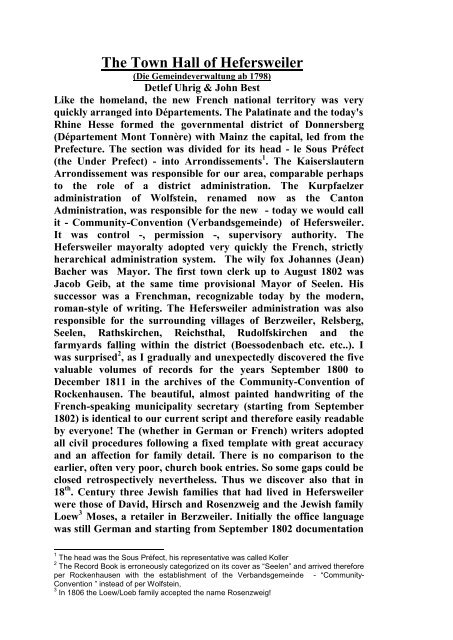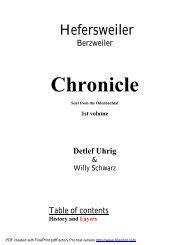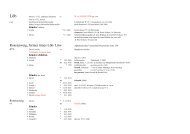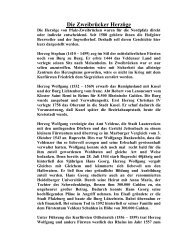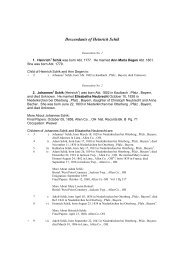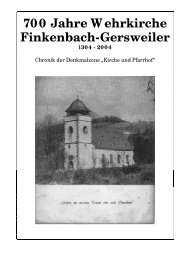The Town Hall of Hefersweiler
The Town Hall of Hefersweiler
The Town Hall of Hefersweiler
You also want an ePaper? Increase the reach of your titles
YUMPU automatically turns print PDFs into web optimized ePapers that Google loves.
<strong>The</strong> <strong>Town</strong> <strong>Hall</strong> <strong>of</strong> <strong>Hefersweiler</strong><br />
(Die Gemeindeverwaltung ab 1798)<br />
Detlef Uhrig & John Best<br />
Like the homeland, the new French national territory was very<br />
quickly arranged into Départements. <strong>The</strong> Palatinate and the today's<br />
Rhine Hesse formed the governmental district <strong>of</strong> Donnersberg<br />
(Département Mont Tonnère) with Mainz the capital, led from the<br />
Prefecture. <strong>The</strong> section was divided for its head - le Sous Préfect<br />
(the Under Prefect) - into Arrondissements 1 . <strong>The</strong> Kaiserslautern<br />
Arrondissement was responsible for our area, comparable perhaps<br />
to the role <strong>of</strong> a district administration. <strong>The</strong> Kurpfaelzer<br />
administration <strong>of</strong> Wolfstein, renamed now as the Canton<br />
Administration, was responsible for the new - today we would call<br />
it - Community-Convention (Verbandsgemeinde) <strong>of</strong> <strong>Hefersweiler</strong>.<br />
It was control -, permission -, supervisory authority. <strong>The</strong><br />
<strong>Hefersweiler</strong> mayoralty adopted very quickly the French, strictly<br />
herarchical administration system. <strong>The</strong> wily fox Johannes (Jean)<br />
Bacher was Mayor. <strong>The</strong> first town clerk up to August 1802 was<br />
Jacob Geib, at the same time provisional Mayor <strong>of</strong> Seelen. His<br />
successor was a Frenchman, recognizable today by the modern,<br />
roman-style <strong>of</strong> writing. <strong>The</strong> <strong>Hefersweiler</strong> administration was also<br />
responsible for the surrounding villages <strong>of</strong> Berzweiler, Relsberg,<br />
Seelen, Rathskirchen, Reichsthal, Rudolfskirchen and the<br />
farmyards falling within the district (Boessodenbach etc. etc..). I<br />
was surprised 2 , as I gradually and unexpectedly discovered the five<br />
valuable volumes <strong>of</strong> records for the years September 1800 to<br />
December 1811 in the archives <strong>of</strong> the Community-Convention <strong>of</strong><br />
Rockenhausen. <strong>The</strong> beautiful, almost painted handwriting <strong>of</strong> the<br />
French-speaking municipality secretary (starting from September<br />
1802) is identical to our current script and therefore easily readable<br />
by everyone! <strong>The</strong> (whether in German or French) writers adopted<br />
all civil procedures following a fixed template with great accuracy<br />
and an affection for family detail. <strong>The</strong>re is no comparison to the<br />
earlier, <strong>of</strong>ten very poor, church book entries. So some gaps could be<br />
closed retrospectively nevertheless. Thus we discover also that in<br />
18 th . Century three Jewish families that had lived in <strong>Hefersweiler</strong><br />
were those <strong>of</strong> David, Hirsch and Rosenzweig and the Jewish family<br />
Loew 3 Moses, a retailer in Berzweiler. Initially the <strong>of</strong>fice language<br />
was still German and starting from September 1802 documentation<br />
1 <strong>The</strong> head was the Sous Préfect, his representative was called Koller<br />
2 <strong>The</strong> Record Book is erroneously categorized on its cover as “Seelen” and arrived therefore<br />
per Rockenhausen with the establishment <strong>of</strong> the Verbandsgemeinde - “Community-<br />
Convention ” instead <strong>of</strong> per Wolfstein,<br />
3 In 1806 the Loew/Loeb family accepted the name Rosenzweig!
was conducted in French only. Mayor Johannes/Jean Bacher was at<br />
the same time also Registrar <strong>of</strong> Births, Marriages and Deaths and<br />
therefore signed with “faisant les fonctions more d'<strong>of</strong>ficier public de<br />
l'état civil”.<br />
Since the Jewish families in Europe obviously had no fixed<br />
surnames and children were named alternately after the father and<br />
then after the mother, the national administrations was <strong>of</strong>ten times<br />
confused. <strong>The</strong> French ministry <strong>of</strong> the Interior issued therefore on<br />
July 20 th , 1806 an Imperial Decree with reference to the Jews who<br />
did not have certain family and first names. <strong>The</strong> citizens <strong>of</strong> our<br />
realm who pr<strong>of</strong>ess themselves to be <strong>of</strong> the Hebrew culture must<br />
accept a surname within three months, - the Biblical first name was<br />
not to be reused as a surname but another city name may be used.<br />
<strong>The</strong> Loebs (Loew) took the name >Rosenzweig< (branch <strong>of</strong> a rose)<br />
and the former Isaak family took the name >Felsenthal< (valley <strong>of</strong><br />
the rocks).<br />
<strong>The</strong> municipal <strong>of</strong>fice (mayoralty and school) <strong>of</strong> <strong>Hefersweiler</strong> was<br />
accommodated in the old building <strong>of</strong> 1696 4 , in which the maître<br />
d'école (schoolmaster) Mohr 5 also taught and lived and starting<br />
from 1803/4 the schoolmaster Heinrich Steinebrey 6 . For the<br />
population a French first name could require some getting used to.<br />
But in any case it was easier stamping SAM, than our Germans<br />
Johannes changed to Jean, Ludwig became Louis, Elisabetha was<br />
now called Lisette. This custom may have continued in existence up<br />
to the Secessionist Period <strong>of</strong> 1922/23.<br />
This introduction <strong>of</strong> the modern, National Register Office resulted<br />
in correct and comprehensive entries, a condition <strong>of</strong> every<br />
efficiently-working administration. Now there were no more<br />
coincidental entries, dependent on the wishes and moods <strong>of</strong> the<br />
respective religious gentlemen! Thank God religion no longer<br />
played a role. Now everyone’s details were captured, no matter<br />
whether they were Catholic, Jewish or Reform. Also the language<br />
became like light verse. No more bad words about illegitimate<br />
children and their mothers. If a wife (e.g. Madame Barbe <strong>The</strong>iss)<br />
bore her second illegitimate child, then the writer noted this without<br />
4 Nevertheless you should visit sometime the old <strong>Hefersweiler</strong> bell <strong>of</strong> 1696, which is located<br />
now in the school hall <strong>of</strong> Berzweiler, first OG!<br />
5 See Family Chronicle, volume 2<br />
6 Heinrich Steinebrey, Born 1 st . May1763 in Relsberg, was - starting in 1804 and up to his<br />
death in 13 March 1835 - a teacher in <strong>Hefersweiler</strong>. He was thus still instructing as 72-year<br />
old. His successor was a teacher from Essweiler – „Barthelmae“
comment. Also the introduction <strong>of</strong> civil marriage began<br />
progressively from September 1798. Weddings were on Sundays,<br />
probably starting from 11 o'clock. At noon, the Mayor Bacher<br />
announced, with a loud voice, the completed marriage ceremony to<br />
the citizenry assembled at the outer door <strong>of</strong> the community center.<br />
Initially the pair who were present before the Registrar <strong>of</strong> Births,<br />
Marriages and Deaths had to have two - then starting from 1802 -<br />
four witnesses to their consent to marriage. In the German Reich,<br />
this progressive law was not used until1876!<br />
Johann Friedrich Daberkow 7 probably came to <strong>Hefersweiler</strong> in<br />
1809. He was single and fell in love with pretty Maria Elisabetha<br />
Bayer. Christmas 1809 was probably the engagement and the bride<br />
and groom visited Jean Bacher, the mayor. He explained the<br />
difficulties to him, particularly since Daberkow originated from the<br />
far-<strong>of</strong>f Kingdom <strong>of</strong> Prussia. Jean Bacher immediately wrote to the<br />
local administration <strong>of</strong> his place <strong>of</strong> residence (Massow in<br />
Pommern). <strong>The</strong> required excerpt from the Birth Register, which<br />
had been issued on 20 May 1810 by the Municipality <strong>of</strong> Massow 8 ,<br />
arrived nearly 10 months later. Mayor Bacher’s report was<br />
celebrated, and he then let the Mayor <strong>of</strong> Niederkirchen examine the<br />
birth entry for Maria Elisabetha Bayer – the birth had taken place<br />
on 3 October 1810 9 . Finally, on 20 th and 27 th <strong>of</strong> January the notice<br />
<strong>of</strong> an intended marriage were hung up on the outer door 10 and the<br />
marriage ceremony took place on February 5 th , 1811. By the way<br />
at that time the beautiful custom arose <strong>of</strong> decorating the <strong>of</strong>ficial<br />
announcement box with seasonal flowers. <strong>The</strong> mother Charlotta<br />
Bayer gave her agreement to the wedding to the notary <strong>of</strong> Wolfstein<br />
Charles Jaques Schuler, because she would certainly have been<br />
7) Johann Friedrich Daberkow was born 2 October 1782 in Massow / Pommern, his<br />
parents were Christoph Daberkow and Dorothea Schmid. By occupation he was butcher, in<br />
other documents he was also designated as “Bader”. According to wedding document N° 3<br />
from 1811 he lived legally in <strong>Hefersweiler</strong>, married Maria Elisabetha Bayer (born 17<br />
March 1789, died 20 June 1861 in Niki) daughter <strong>of</strong> Charlotta Bayer and Johann Peter<br />
Steinhauer on 5 February 1811 in the community centre in <strong>Hefersweiler</strong>.<br />
8) As at March 1813 <strong>The</strong> Kingdom <strong>of</strong> Prussia still belonged to friendly, but dependent<br />
states <strong>of</strong> France. Only in 1813 did Prussia separate itself from Napoleonic clutches and<br />
followed Russia!<br />
9) <strong>The</strong> Lutheran-Evangelist Church book lay in the Mayor’s Office <strong>of</strong> Niederkirchen. As for<br />
<strong>Hefersweiler</strong> above, representation <strong>of</strong> Berzweiler and Relsberg belonged to the Niki<br />
Kirchenspiel.<br />
10 ) Witnesses at the marriage were Jakob Römer, 41 J. farmer <strong>of</strong> <strong>Hefersweiler</strong>, Michael<br />
Kopp, 45, butcher in <strong>Hefersweiler</strong>, Heinrich Steinebrei, schoolmaster, 49 J. and Friedrich<br />
Philipp Simon Schwartz, (born 13 December 1782 in Rudolfskirchen - see family album).<br />
tailor from <strong>Hefersweiler</strong>! On 10 March 1807 Schwartz had married Catharina Bayer, a<br />
cousin Maria Elisabetha Bayer!
mocked by some people, if she had appeared at the wedding in<br />
<strong>Hefersweiler</strong> 11 !<br />
11 ) As a 25-year old Charlotta Bayer had already had 1780 illegitimate child. And that at a<br />
time before revolutionary era, was a serious misdemeanour. Her second illegitimate child<br />
came when she was 34 years’ old. <strong>The</strong> father was (as the minister Vollmar wrote) the<br />
“stupid, lascivious very old man Johann Peter Steinhauer, the proud master father <strong>of</strong> many<br />
people in <strong>Hefersweiler</strong> and Berzweiler. Even if a pot would call Charlotta Bayer the black<br />
kettle, Charlotta must nevertheless from today's more objective viewpoint , be judged a<br />
success in bringing up, largely alone, her children Johann Nickel and Maria Elisabetha in<br />
that arduous time. One must conclude that she was a great person, who took life what life<br />
handed out while receiving nothing from her relationship to the Steinhauers.


